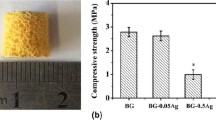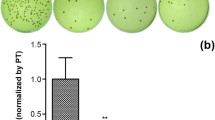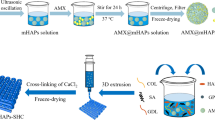Abstract
Bone infections in human beings are an essentially destructive problem with crucial clinical and economic effects; thus, incorporation of antibiotics such as amoxicillin (AMX) into the scaffold was developed as an effective treatment for bone infections. In this respect, we develop new nanostructured bredigite (Bre; Ca7MgSi4O16)–amoxicillin (AMX; α-amino-hydroxybenzyl-penicillin) scaffolds containing different concentrations of amoxicillin (0, 3, 5, and 10%) by using space holder method to assure bactericidal properties. The result depicted that the Bre–AMX scaffolds possess porosity of 80–82% with high compressive strength of 1.2–1.4 MPa and controlled antibiotic release for prevention of infection. Bre–(3–10%)AMX scaffolds were able to destroy Staphylococcus aureus (S. aureus) and Escherichia coli (E. coli) bacteria, as well as effectively inhibit the growth of bacterial cells; in addition, the antibacterial activity of the AMX-loaded scaffolds augmented with the increase of the AMX concentration. Sustained drug release was detected from Bre–AMX scaffolds accompanied by initial burst release of 20% for 8 h, followed by a sustained release, which is favorable for bone infection treatment. These new Bre–(3–5%)AMX scaffolds possess excellent mechanical properties and antibacterial activity with no cytotoxicity suggested as an appropriate alternative for bone infection treatment.











Similar content being viewed by others
References
Sadeghzade S, Shamoradi F et al. (2017) Fabrication and characterization of baghdadite anostructured scaffolds by space holder method. J Mech Behav Biomed Mater 68:1–7
Kariem H, Pastrama M-I et al. (2015) Micro-poro-elasticity of baghdadite-based bone tissue engineering scaffolds: a unifying approach based on ultrasonics, nanoindentation, and homogenization theory. Mater Sci Eng C 46:553–564
Roohani-Esfahani S-I, Chen Y et al. (2013) Fabrication and characterization of a new, strong and bioactive ceramic scaffold for bone regeneration. Mater Lett 107:378–381
Eilbagi M, Emadi R et al. (2016) Mechanical and cytotoxicity evaluation of nanostructured hydroxyapatite-bredigite scaffolds for bone regeneration. Mater Sci Eng C 68:603–612
Zreiqat H, Ramaswamy Y et al. (2010) The incorporation of strontium and zinc into a calcium–silicon ceramic for bone tissue engineering. Biomaterials 31:3175–3184
Olalde B, Garmendia N et al. (2013) Multifunctional bioactive glass scaffolds coated with layers of poly(d,l-lactide-co-glycolide) and poly(n-isopropylacrylamide-co-acrylic acid) microgels loaded with vancomycin. Mater Sci Eng C 33:3760–3767
Schumacher TC, Volkmann E et al. (2014) Mechanical evaluation of calcium-zirconium-silicate (baghdadite) obtained by a direct solid-state synthesis route. J Mech Behav Biomed Mater 34:294–301
Zhai W, Lu H et al. (2013) Stimulatory effects of the ionic products from Ca–Mg–Si bioceramics on both osteogenesis and angiogenesis in vitro. Acta Biomater 9:8004–8014
Diba M, Goudouri O-M et al. (2014) Magnesium-containing bioactive polycrystalline silicate-based ceramics and glass-ceramics for biomedical applications. Curr Opin Solid State Mater Sci 18:147–167
Tavangarian F, Emadi R (2011) Mechanism of nanostructure bredigite formation by mechanical activation with thermal treatment. Mater Lett 65:2354–2356
Antoci JV, Adams CS et al. (2008) The inhibition of Staphylococcus epidermidis biofilm formation by vancomycin-modified titanium alloy and implications for the treatment of periprosthetic infection. Biomaterials 29:4684–4690
Rumian Ł, Tiainen H et al. (2017) Ceramic scaffolds with immobilized vancomycin-loaded poly(lactide-co-glycolide) microparticles for bone defects treatment. Mater Lett 190:67–70
García-Alvarez R, Izquierdo-Barba I et al. (2017) 3D scaffold with effective multidrug sequential release against bacteria biofilm. Acta Biomater 49:113–126
Parent M, Magnaudeix A et al. (2016) Hydroxyapatite microporous bioceramics as vancomycin reservoir: antibacterial efficiency and biocompatibility investigation. J Biomater Appl 31:488–498
Wang S, Zheng F et al. (2012) Encapsulation of amoxicillin within laponite-doped poly(lactic-co-glycolic acid) nanofibers: preparation, characterization, and antibacterial activity. ACS Appl Mater Interfaces 4:6393–6401
Songsurang K, Pakdeebumrung J et al. (2011) Sustained release of amoxicillin from ethyl cellulose-coated amoxicillin/chitosan–cyclodextrin-based tablets. AAPS PharmSciTech 12:35–45
Sadeghpoura S, Amirjanib A, Hafezib M, Zamanian N,A (2017) Fabrication of a novel nanostructured calcium zirconium silicate scaffolds prepared by a freeze-casting method for bone tissue engineering. Ceram Int 40:16107–16114
Iviglia G, Cassinelli C et al. (2016) Engineered porous scaffolds for periprosthetic infection prevention. Mater Sci Eng C 68:701–715
Ghomi H, Emadi R et al. (2016) Fabrication and characterization of nanostructure diopside scaffolds using the space holder method: effect of different space holders and compaction pressures. Mater Des 91:193–200
Unnithan AR, Nejad AG et al. (2016) Electrospun zwitterionic nanofibers with in situ decelerated epithelialization property for non-adherent and easy removable wound dressing application. Chem Eng J 287:640–648
Mirahmadi F, Tafazzoli-Shadpour M et al. (2013) Enhanced mechanical properties of thermosensitive chitosan hydrogel by silk fibers for cartilage tissue engineering. Mater Sci Eng C 33:4786–4794
Williamson GK (1953) X-ray line broadening from filed aluminium and wolfram. Acta Metall 1:22–31
Mirhadi SM, Tavangarian F et al. (2012) Synthesis, characterization and formation mechanism of single-phase nanostructure bredigite powder. Mater Sci Eng C 32:133–139
Sabree I, Gough JE, Derby B (2015) Mechanical properties of porous ceramic scaffolds: influence of internal dimensions. Ceram Int 41:8425–8432
Salma-Ancane K, Stipniece L, Putnins A, Berzina-Cimdin L (2015) Development of Mg-containing porous β-tricalcium phosphate scaffolds for bone repair. Ceram Int 41:4996–5004
Khodaei M, Meratian M, Savabi O (2015) Effect of spacer type and cold compaction pressure on structural and mechanical properties of porous titanium scaffold. Powder Metall 58:152–159
Roohani-Esfahani S-I, Nouri-Khorasani S, Lu Z, Appleyard R, Zreiqat H (2010) The influence hydroxyapatite nanoparticle shape and size on the properties of biphasic calcium phosphate scaffolds coated with hydroxyapatite–PCL composites. Biomaterials 31:5498–5509
Wu C, Chang J et al. (2005) Preparation and characteristics of a calcium magnesium silicate (bredigite) bioactive ceramic. Biomaterials 26:2925–2931
Lopes JH, Magalhães JA, Gouveia RF, Bertran CA, Motisuke M, Camargo SEA, Trichês EdS (2016) Hierarchical structures of β-TCP/45S5 bioglass hybrid scaffolds prepared by gelcasting J Mech Behav Biomed Mater 62:10–23
Salim MM, Malek NANN (2016) Characterization and antibacterial activity of silver exchanged regenerated NaY zeolite from surfactant-modified NaY zeolite. Mater Sci Eng C 59:70–77
Sangeetha K, Yokogawa Y, Girija EK (2015) A facile strategy to elute amoxicillin in a controlled way from hydroxyapatite-gelatin composite. Adv Mater Lett 6:1031–1036
Zheng F, Wang S et al. (2013) Characterization and antibacterial activity of amoxicillin-loaded electrospun nano-hydroxyapatite/poly(lactic-co-glycolic acid) composite nanofibers. Biomaterials 34:1402–1412
Furtos G, Rivero G, Rapuntean S, Abraham GA (2017) Amoxicillin-loaded electrospun nanocomposite membranes for dental applications. J Biomed Mater Res B Appl Biomater 105:966–976
Diba M, Kharaziha M et al. (2012) Preparation and characterization of polycaprolactone/forsterite nanocomposite porous scaffolds designed for bone tissue regeneration. Compos Sci Technol 72:716–723
Wang S, Castro R et al. (2012) Electrospun laponite-doped poly (lactic-co-glycolic acid) nanofibers for osteogenic differentiation of human mesenchymal stem cells. J Mater Chem 22:23357–23367
Ghadiri S, Hassanzadeh-Tabrizi SA, Bigham A (2017) The effect of synthesis medium on structure and drug delivery behavior of CTAB-assisted sol–gel derived nanoporous calcium–magnesium–silicate. J Sol Gel Sci Technol 83:229–236
Vassilakopoulou A, Dimos K, Kostas V, Karakassides MA, Koutselas I (2016) Synthesis and characterization of calcium oxyboroapatite with bimodal porosity. J Sol Gel Sci Technol 78:339–346
Hendrikx S, Kuzmenka D, Köferstein R et al. (2017) Effects of curing and organic content on bioactivity and mechanical properties of hybrid sol–gel glass scaffolds made by indirect rapid prototyping. J Sol Gel Sci Technol 83:143–154
Ghomi H, Fathi MH, Edris H (2011) Preparation of nanostructure hydroxyapatite scaffold for tissue engineering applications. J Sol Gel Sci Technol 58:642–650
Bakhsheshi-Rad HR, Hamzah E, Ismail AF, Aziz M, Daroonparvar M, Saebnoori E, Chami A (2018) In vitro degradation behavior, antibacterial activity and cytotoxicity of TiO2 -MAO/ZnHA composite coating on Mg alloy for orthopedic implants. Surf Coat Technol 334:450–460
Bakhsheshi-Rad HR, Hamzah E, Tok HY, Kasiri-Asgaran M, Jabbarzare S, Medraj M (2017) Microstructure, In Vitro Corrosion Behavior and Cytotoxicity of Biodegradable Mg-Ca-Zn and Mg-Ca-Zn-Bi Alloys. J Mater Eng Perform 26:653–666
Acknowledgements
The authors would like to thank the Malaysian Ministry of Higher Education (MOHE) and Universiti Teknologi Malaysia for providing financial support and facilities for this research.
Author information
Authors and Affiliations
Corresponding author
Ethics declarations
Conflict of interest
The authors declare that they have no conflict of interest.
Additional information
Highlights
-
Novel bredigite-amoxicillin scaffolds were prepared using the space holder method.
-
Bre-AMX scaffold possess compressive strength of 1.2 MPa with porosities of 80%.
-
The Bre-AMX scaffolds presented desired drug release trend during 48 h.
-
Antimicrobial activity and cytocompatibility of Bre-AMX scaffolds were evaluated.
Rights and permissions
About this article
Cite this article
Bakhsheshi-Rad, H.R., Hamzah, E., Abbasizadeh, N. et al. Synthesis of novel nanostructured bredigite–amoxicillin scaffolds for bone defect treatment: cytocompatibility and antibacterial activity. J Sol-Gel Sci Technol 86, 83–93 (2018). https://doi.org/10.1007/s10971-018-4606-1
Received:
Accepted:
Published:
Issue Date:
DOI: https://doi.org/10.1007/s10971-018-4606-1




